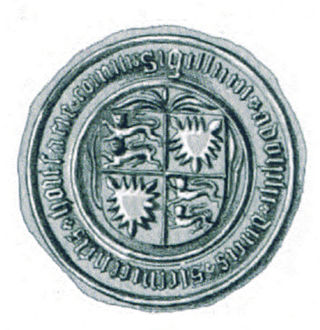Related Research Articles

Valdemar II Valdemarsen, later remembered as Valdemar the Victorious, was King of Denmark from 1202 until his death in 1241.

Valdemar IV Atterdag, or Waldemar was King of Denmark from 1340 to 1375. He is mostly known for his reunion of Denmark after the bankruptcy and mortgaging of the country to finance wars under previous rulers.

Eric IV, also known as Eric Ploughpenny or Eric Plowpenny, was King of Denmark from 1241 until his death in 1250. His reign was marked by conflict and civil wars against his brothers.

Christopher II was King of Denmark from 1320 to 1326 and again from 1329 until his death. He was a younger son of Eric V. His name is connected with national disaster, as his rule ended in an almost total dissolution of the Danish state.

Valdemar III (1314–1364) was King of Denmark from 1326 to 1329, while he was underage; he was also Duke of Schleswig as Valdemar V in 1325–26 and from 1330 to 1364. He was a rival king set up against the unsuccessful Christopher II and was widely opposed by his subjects. His term was ended when he abdicated. Sometimes the earlier King Valdemar the Young (c. 1209–1231) is also referred to as Valdemar III.

Adolphus XI of Schauenburg, as Adolph I Duke of Schleswig, and as Adolph VIII Count of Holstein-Rendsburg, was the mightiest vassal of the Danish realm.
The Treaty of Ribe was a proclamation at Ribe made in 1460 by King Christian I of Denmark to a number of Holsatian nobles enabling himself to become Count of Holstein and gain control of the Duchy of Schleswig. The most famous line of the proclamation was that the Danish Duchy of Schleswig and the County of Holstein within the Holy Roman Empire, should now be, in the original Middle Low German language, Up Ewig Ungedeelt, or "Forever Undivided".

Gerhard III of Holstein-Rendsburg, sometimes called Gerhard the Great, and in Denmark also known as Count Gert or den kullede greve, was a German prince from the Schauenburg family who ruled Holstein-Rendsburg and a large part of Denmark during the interregnum of 1332–40.

John III of Holstein-Plön, called John the Mild, was a Count of Schauenburg and Holstein-Plön and Holstein-Kiel, ruling Holstein-Plön and Holstein-Kiel (1316–1359). Together with Count Gerhard III of Holstein-Rendsburg, John III was the lord ruling in guardianship the Danish Duchy of Schleswig 1332–1340. He was known as “John the Mild”.

Niels Ebbesen was a Danish squire and national hero, known for his killing of Gerhard III, Count of Holstein-Rendsburg in 1340. From 1332 to 1340, Count Gerhard was the lord of both Jutland and Funen. His death meant the end of Holstein rule in Denmark.

The Counts of Schauenburg and Holstein were titles of the Frankish Empire. The dynastic family came from the County of Schauenburg near Rinteln on the Weser in Germany. Together with its ancestral possessions in Bückeburg and Stadthagen, the House of Schauenburg ruled the County of Schauenburg and the County of Holstein. The comital titles of Holstein were subject to the liege lord, the Dukes of undivided Saxony till 1296, and thereafter the Dukes of Saxe-Lauenburg.

Randers is a city in Randers Municipality, Central Denmark Region on the Jutland peninsula. It is Denmark's sixth-largest city, with a population of 62,802. Randers is the municipality's main town and the site of its municipal council. By road it is 38.5 kilometres (23.9 mi) north of Aarhus, 43.8 kilometres (27.2 mi) east of Viborg, and 224 kilometres (139 mi) northwest of Copenhagen.

Helvig of Schleswig was the queen of Denmark as the spouse of King Valdemar IV. She was the mother of Queen Margaret I of Denmark.

The House of Estridsen was a dynasty that provided the kings of Denmark from 1047 to 1412. The dynasty is named after its ancestor Estrid Svendsdatter. The dynasty is sometimes called the Ulfinger, after Estrid's husband, Ulf Jarl. The dynasty also provided three of the rulers of Sweden in the years 1125–1412. Their family coat of arms became the coat of arms of Denmark and therefore influenced the coat of arms of Tallinn and the coat of arms of Estonia.

Henry I, Count of Holstein-Rendsburg (1258–1304) was the first Count of Holstein-Rendsburg.
Eric Christoffersen was king of Denmark from 1321 until his death, jointly with his father, King Christopher II. He was a member of the House of Estridsen. In Danish, he is sometimes called "Erik, elected king."
The Wars of the Rügen Succession were two early 14th century conflicts fought primarily between Mecklenburg and Pomerania for control of the Danish Principality of Rügen on the southern Baltic Sea coast.
Events from the 14th century in Denmark.
Events from the 1360s in Denmark.
Events from the 1320s in Denmark.
References
- ↑ "Valdemar 4. Atterdag" (in Danish). Dansk Biografisk Leksikon. Retrieved 2 March 2023.
- ↑ "Valdemar Atterdag og genopbygning af kongemagten 1340-75". danmarkshistorie (Aarhus University). Archived from the original on April 21, 2021. Retrieved August 1, 2018.
- ↑ "Aalborg". Dansk Center for Byhistorie (in Danish). Retrieved 2 March 2023.
- ↑ "Åkirkeby". denstoredanske.dk (in Danish). Retrieved 2 March 2023.